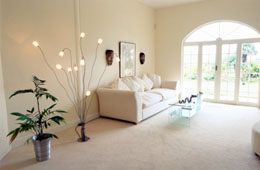Indoor plant lights are meant to help the plants grow as well as to illuminate and highlight them.

It is an absolute delight to have plants around you in your dwelling. Plants like ferns, a few types of cactus, and small flowering ones can instantly impart a pleasing look to your house. The green color is refreshing and surely has therapeutic effects. Indoor plants however, need a bit more care than the usual outdoor plants because of various factors.
One of the most important factors being light. As indoor plants sometimes do not get adequate light, they need another source of it. This is where indoor plant lights come into the picture. These lights are basically of 4 types―fluorescent, incandescent, LED, and high pressure bulbs.
Fluorescent Bulbs/Lights
These are the most popular and commonly available lights and in any desired wattage and color temperature. Standard fluorescent lights in the range of 2800 K to 6000 K are typically fit for growing vegetables like leaf lettuce, spinach, and herbs. These are also good for giving seedlings a jump start on spring planting. When there is a limited space vertically, a HO fluorescent fixture having a very thin profile is perfect.
Incandescent Lights
These lights have a low color temperature, around 2700 K and these are not exactly those which can be categorized as grow lights. These are best used as a highlighting device for indoor plant groupings, though they are sometimes labeled as grow lights. The average life span of these lights is somewhere around 750 hours. If you are looking at energy saving, these types may not turn out to be a good choice for your indoor or house plants.
Metal Hallide Lights
Metal hallide (MH) indoor plant light bulbs are amongst the best indoor plant lights. Abbreviated as MH, these are very efficient grow lights for indoor plants. A bluer spectrum emits a good amount of light, encouraging and helping growth in indoor plants. In addition to this, these light are cost-effective too, making them even more viable and best in the job.
High Pressure Sodium Lights
Giving a tough competition to the metal hallide lamps are the High Pressure Sodium (HPS) lamps or bulbs. These bulbs have reddish orange light which stimulates the growth of budding and flowering plants. However, these lights do not have the blue spectrum which contributes to the growth of leafy green plants. The life of HPS lights is around 1800 hours.
LED Lights
Light emitting diode or LED lights are a recent development in the lights used for plant growth. These are going to be an exciting offering in the time to come as grow lights, but as of now, these are not as efficient as the other types of lights.
In addition to all these, sometimes a combination of MH and HPS lights is a very good option to make the indoor plants grow. In the opinion of the specialists and manufacturers, the combination of the two results in ideal spectral blend and very high outputs. There are though doubts about this aspect.
Out of these, MH and HPS are high intensity discharge lamps and are the best amongst the lot. But just the lights won't work. You need indoor plant light stands or indoor plant stands and other equipment with it for ensuring that the plants grow well. That includes fans, reflectors, and a timer. Reflectors are important around the planting for reflecting the light back on plants, and the fans help in optimizing ventilation for the plant, leading to strong roots and stems.






 It is an absolute delight to have plants around you in your dwelling. Plants like ferns, a few types of cactus, and small flowering ones can instantly impart a pleasing look to your house. The green color is refreshing and surely has therapeutic effects. Indoor plants however, need a bit more care than the usual outdoor plants because of various factors.
It is an absolute delight to have plants around you in your dwelling. Plants like ferns, a few types of cactus, and small flowering ones can instantly impart a pleasing look to your house. The green color is refreshing and surely has therapeutic effects. Indoor plants however, need a bit more care than the usual outdoor plants because of various factors.